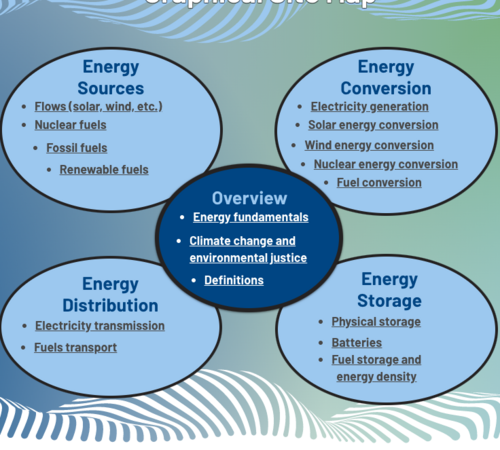
The Yale Energy History Project has launched a new website, “Energy Basics,” to help teach the fundamentals of energy systems in humanities and social science classes and to the general public. Noreen Gentry (‘22 PhD) and Claire Cody (‘23 PhD, expected), from the Department of Chemistry, created the website, located at energybasics.org, working in collaboration with Paul Sabin, Randolph W. Townsend, Jr. Professor of History and Professor of American Studies.
“Energy Basics” dives into the various sources of power that fuel transportation and industry, and heat and light homes and offices. “The website provides short, clear explanations of energy systems to provide valuable context for studying the history, politics, and culture of energy,” said Sabin. The content is presented in digestible bites for easy reading. At the bottom of each page, links to outside sources and open-ended questions encourage further research and discussion.
“One of our main goals for the site was to provide a comprehensive overview of key energy issues, without it getting too overwhelming or unwieldy,” explained Cody.
The website aims to provide a foundational understanding of energy while encouraging curiosity. It is divided into four main categories: Sources, Conversion, Distribution, and Storage, each providing information on various aspects of energy. Users can find pages that concisely explain how photovoltaic panels work, for example, or the processes behind nuclear fission reactors.
Inspiration for the website came somewhat by chance. Gentry recounted that, as a graduate student in the chemistry department, she initially contacted Professor Sabin to audit his Yale course on American Energy History. The two quickly discovered a shared ambition to find effective ways to communicate energy science and technology to broader audiences.
“As we talked more, we found an overlap of interests in explaining energy concepts in an accessible way to non-scientists, particularly for his class,” said Gentry.
Gentry and Cody began creating teaching modules for Sabin’s class and as a resource for other teachers and the general public. The effort pushed them to use their chemistry backgrounds to distill complex scientific topics in clear terms. A page on electricity transmission, for instance, explains how electricity is transported across distances through a network of stations, substations, and transmission lines. Because electricity is a flow of electrons, it must be used immediately once it is generated and power grid systems must be designed to balance demand and generation, and to avoid electricity blackouts or brownouts.
“The goal is to foster more dialogue about our energy choices and their social and environmental consequences,” said Sabin. “We’re excited to introduce this resource to the community so they can become better aware of the fundamental science behind energy technologies and the social and political choices that get made about energy systems.”
“I hope that the site is accessible to any reader, and that it ends up being useful for people to learn about important energy topics,” said Cody. “Ideally, it inspires people to continue learning and exploring more!”
The Energy Basics website was sponsored by the Yale Energy History Project.